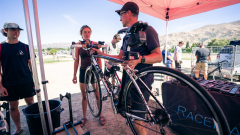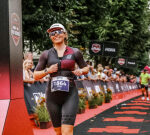The RaceRanger draft detection technology took a significant step forward over the weekend when it was used for an Age Group event for the first time.
Pretty much all the biggest professional races now use the system and the T100 Triathlon World Tour saw its first drafting penalties handed out last season, with none other than double Olympic champion Alistair Brownlee on the receiving end.
And the IRONMAN World Championships – both full and middle-distance – plus the iconic Challenge Roth are other events to feature the technology which assists referees in determining whether or not an athlete is drafting during a race.
But there was a very different test for the system at the scenic Challenge Wanaka in the South Island of New Zealand – with the three-figure field of Age Groupers far larger than restricted pro line ups.
Challenge Wanaka was used as one of the first pro trials for RaceRanger back in 2023, with former IRONMAN World Champion Sebastian Kienle describing it afterwards as “the perfect tool for the perfect time” but this time there was no pro race and the focus was very much on the amateurs.
And we’ve caught up with James Elvery, the RaceRanger CEO, to find out how this latest stage in its development went, from implementation through to feedback and learnings.
Pre-race setup
In total 270 athletes used the system, which constituted all age groups up to 55yrs, with Elvery saying they had to make a call in conjunction with Challenge on which to leave out as entries exceeded the number of units they currently have operational.

In terms of actually getting the units onto the bikes, Elvery explained: “Something we wanted to get out of the trial was hands-on experience with age grouper bikes, and to understand the subtle differences between them and the pros. It’s one thing to look at these bikes in transition areas, quite another to physically fit units to them.
“Of the 270 athletes that used the system, we encountered just one bike we weren’t able to mount a rear unit to. In this case it was a particularly small frame size Cervelo, and the whole rear seat-post area was taken up by the athlete’s rear water bottle which was a seat-post mounted type system. If they had switched this to a saddle rails mount system or similar, this would have freed up the space we needed. More research is needed in this area, but overall it was a very encouraging experience.”

The system in action
While a relatively small field compared to a lot of other age group races, those 270 athletes were mixed on course with around 500 cyclists from teams, who didn’t have units on their bikes.
The bike course was 90km in total – three laps of 15km out and 15km back from Wanaka. Elvery describes it as “quite a narrow and lumpy piece of road”, adding: “So overall it wasn’t an ‘inevitable peloton’ type of race, but it also wasn’t that spread out.”
With the increased numbers RaceRanger added a new feature, with the devices now turning themselves on pre-race. Elvery said the thinking there was: “Previously we’ve been giving them each an NFC tap with a phone each to wake them. While fine for 75 pros, this won’t scale to the 1000’s well.”
And Elvery admits that what he saw during the race has already changed his perspective: “The key learning for me personally was that athletes across the spectrum of experience and ability levels all seemed to be using or at least making an effort to use the lights as intended,” he explained.
“I had gone in with a theory that the ‘average’ Age Grouper, who isn’t particularly serious or super competitive, but who might be more concerned with getting to the finish, having a good time, and completing a personal fitness challenge – that they might not be that interested or see the value in having a system to prevent drafting.
“My thinking was that for this group there wouldn’t be much perceived value in the anti-drafting aspect. But my impression now is that this didn’t appear to be the case. We saw from the roadside that athletes throughout the field were actively using the system as intended.”
How many penalties were handed out?
And that aspect was underlined by feedback from both athletes and officials.
Elvery added: “Athlete feedback has been really positive so far. I managed to get immediate feedback from around 40 athletes in transition after they racked their bike and prepared for the run.




